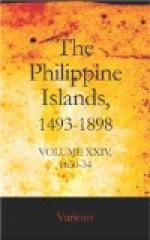While on the way to the island of Panay, my boat was overturned by a heavy storm, and it was a miracle that I escaped with my life—which happened, through God’s mercy, by the efforts of my Sugbu Indians. Finally when the storm was appeased, I reached the convent of Salog, without shoes, naked, and perishing of hunger, on the fifteenth of the said month of April. The father of that convent, called father Fray Francisco de Oliva, [71] and all the others of that island, aided both the convent, and me especially, with the greatest charity. Thus I obtained there two very large contributions of all necessary for the convent. I found father Fray Esteban de Peralta, definitor of the province, there visiting the island. I went to Manila with him, where I tried to go from Manila to Espana. The superior did not impose obedience in regard to it, so that I turned all my efforts to caring for my house, for which many religious aided from their stores with great charity.
At this juncture the ships came from Espana. They brought the governor’s wife, Dona Magdalena de Onate. They had been four whole months in making the port of Cavite and had suffered very severe weather. Those two ships were very staunch ones, and had better accommodations for cargo than any that have been seen in the islands. They were called the “San Luis” and the “San Raimundo.” As commander of the flagship came Don Juan de Quinones, in whose ship sailed the governor’s wife. It also bore the religious of our father St. Dominic; while in the almiranta sailed Don Diego Munoz, Bishop Don Fray Hernando Guerrero, the latter of whom was at the point of death, so that his escape was a marvel. We saw above how our father Mentrida sent him to Espana as procurator. He made a prosperous trip [to Espana], and when he reached Espana found himself a bishop, a negotiation effected by heaven rather than his own efforts. For one always recognized very great grace (I mean humility) in his Lordship, like the grand religious that he always was. But his many hardships, journeys, and services in the islands made him worthy of this and of other greater honors. He went and returned in three years, bringing an unusually fine company [of religious]. But the plague decimated them, taking the best of the men, as follows:
1. Father Fray Francisco Osorio, reader of theology in Espana, and an eloquent preacher; and, above all, of most noble temper and blood.
2. Father Fray Juan Bermans, a preacher from Flanders. He died chaste; and was a brother of Father Bermans of the Society, who is to be canonized, and who serves as a model.
3. Father Fray Diego Bonifaz, a very virtuous religious.
4. Father Fray Bartolome de Eraso, a preacher and quite indispensable.
5. Brother Fray Francisco Gonzalez, chorister.
6. Brother Fray Francisco Diego, chorister.
7. Brother Fray Antonio de Salazar, chorister.




